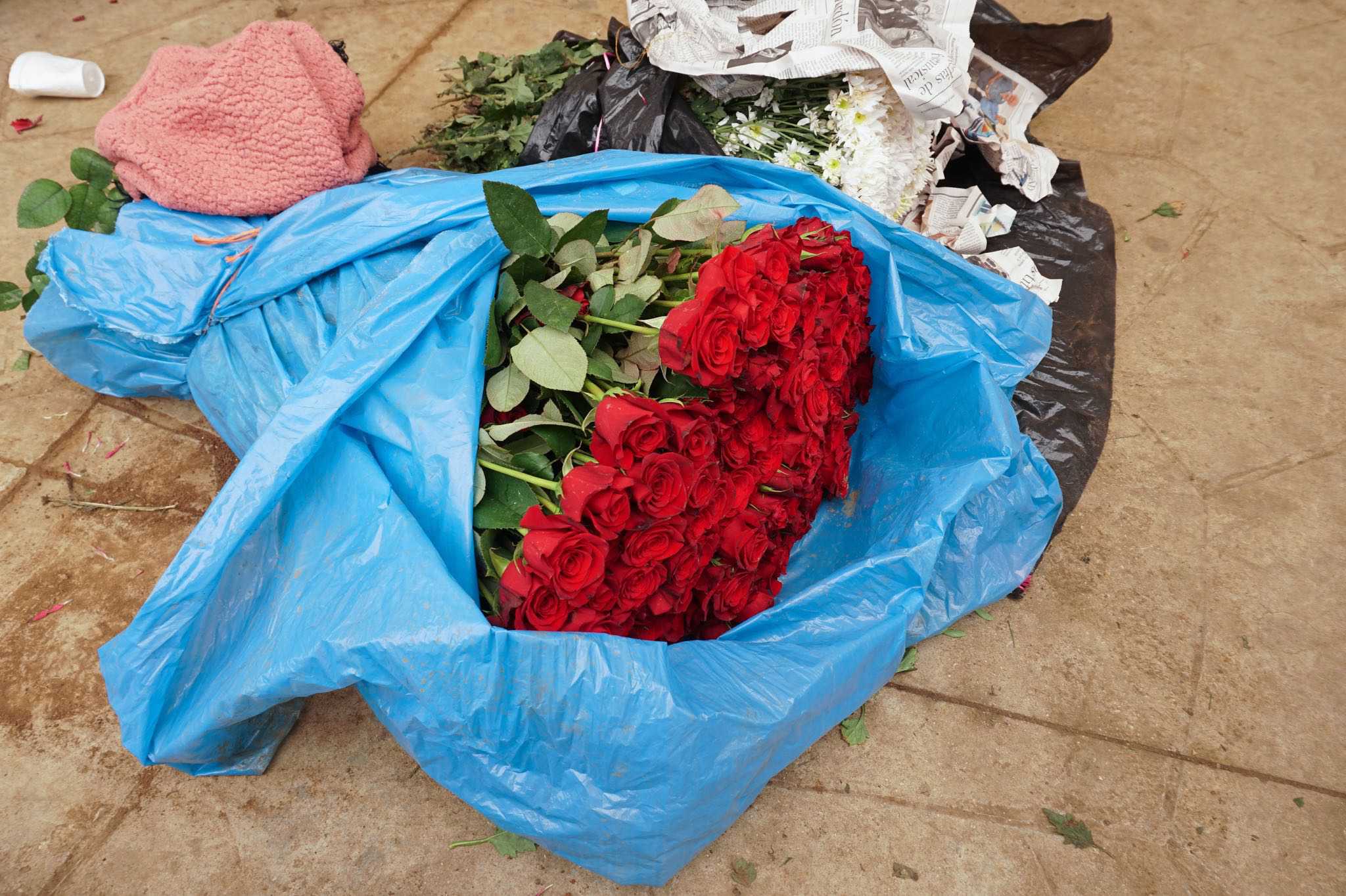
Adriana Alcázar González, GPJ Mexico
Flower vendors display roses, chrysanthemums, carnations and other flowers at the municipal market in Zinacantán, Mexico.
ZINACANTÁN, MEXICO — Pedro González Hernández walks slowly between rows of chrysanthemums, baby’s breath and roses — red, pink, yellow and white, not yet in full bloom — scanning for traces of imperfection or sickness.
“This greenhouse only has 10,000 plants,” he says. “It’s one of the smallest.”
In this municipality in the Chiapas highlands in southern Mexico, growers cultivate nearly 40% of the land with flowers. There are about 1,200 floriculturists in Zinacantán, most of them Mayan Tsotsil small-scale growers like González Hernández, 26, whose family began growing flowers 15 years ago, when they pivoted away from beans and corn. Commercial floriculture, initially developed through government support in 1973, is now a mainstay of the local economy and culture: Flowers adorn pantheons and churches during weddings, baptisms and birthdays, while the mountains are dotted with an estimated 5,000 greenhouses. Most of this, however, relies on increasingly precarious imported inputs.
“The prices of chemicals have doubled or tripled,” says González Hernández, referring to the fungicides, foliar sprays and root fertilizers his flowers require. According to Banco de México, Mexico’s central bank, the country imports two-thirds of its nitrogen fertilizer, much of it from Russia. “They’re saying it’s because of the war [in Ukraine], because some of the chemicals come from those places and with the war, they can’t leave.”






The supply chain disruption has hit Julio Martín Hernández Pérez, 42, so hard that he supplements his income with construction work. Last year, a bag of fertilizer cost 500 Mexican pesos ($25); now, it costs 1,500 pesos ($76). “Right now, I only have three greenhouses with flowers,” he says. For the venture to be feasible, he is looking to add two more. “I’m trying to save up … but it’s slow going because now everything has gone up in price.”
Setting up a greenhouse, Hernández Pérez says, can require an initial investment of up to 50,000 pesos ($2,546). This includes renting land with adequate water and power, and purchasing materials for the structure — such as thick plastic for cover, lumber, staples and nails — as well as flower seedlings. To achieve this, he will “also have to ensure he can afford to buy the chemical inputs necessary to grow perfect flowers,” says Jorge Alberto López Arévalo, an economics professor at the Autonomous University of Chiapas. Price hikes are threatening floriculture in places like Zinacantán, he says.
Zinacantán municipal authorities did not respond to requests for comment.
Local growers can’t help but feel an existential gloom. “Flowers make a lovely gift,” says González Hernández. “They are capable of conveying love, affection and even admiration with their beauty. But they are not essential for living. So there are times when people might wait to purchase them.”
Price increases end up being transferred to the consumer, says Araceli Montes, who sells arrangements in San Cristóbal de Las Casas and sources her flowers from Zinacantán. “During the last year, flower prices have been chaotic, always on the rise. A rose that usually costs two and a half pesos can cost 10 or 12 pesos during the festive season — but watch out, that same flower could be found for a peso, a peso and a half last year.”



Others, however, sense opportunity. Floriculture’s current reliance on externally sourced chemical inputs is neither feasible nor ecologically sustainable, says agricultural engineer Ambrosio Díaz Santiz, an independent advisor who, despite being an agrochemical supplier, suggests that growers in Zinacantán consider transitioning to natural inputs such as compost and biofertilizers. Because these are locally sourced, they are less susceptible to international geopolitical fluctuations; moreover, they are less harmful for consumers and growers.
“Many times, there is indiscriminate use of agrochemicals because there is no permanent technical support,” he says. “Growers apply agrochemicals without protection, other than handkerchiefs on their faces or long-sleeve shirts.” They often learn to use the toxic chemicals based on the experience of friends and family or through risky experimentation in greenhouses, he adds, which can raise health concerns.
“These days, consumers are demanding organic food products,” Díaz Santiz says. “So, why not give thought to flowers without chemicals, flowers that may not be perfect but that are free of chemicals and are healthy to smell and touch?”
Hernández Pérez is attempting exactly that. He now uses compost to fertilize the soil in one of his greenhouses. “The flowers are small,” he says, adding that they also take longer to bloom. Sometimes there is discoloration on the petals or leaves. This may seem minor, but looks count in this industry. There is no significant market for chemical-free flowers, he says.
“Nobody wants to buy a rose with spots. Everyone wants flowers or buds that are big, beautiful and smooth.”
Adriana Alcázar González is a Global Press Journal reporter based in Chiapas, Mexico.
TRANSLATION NOTE
Shannon Kirby, GPJ, translated this story from Spanish.






